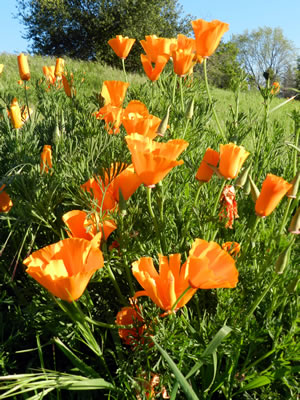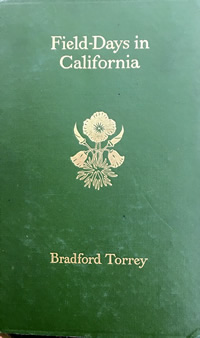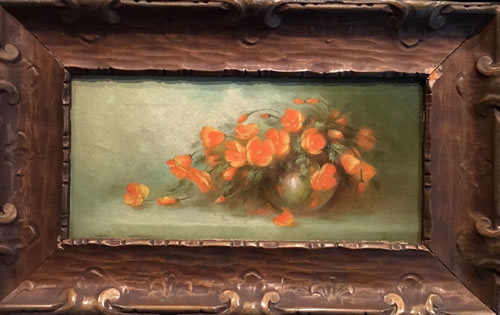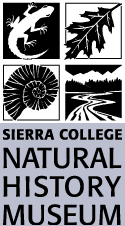California Poppy
Joe Medeiros
Professor Emeritus, Botany, Sierra College

Parked on the roadside in California on a sunny spring day, passersby admire and photograph the state’s brilliant orange, floral symbols. Their young daughter grabs a handful of the dazzling blooms, only to be stopped by her parents’ puzzled looks. Can she keep the cluster as a bouquet to take home? Is this legal? Aren’t poppies illegal to pick?
The California poppy (Eschscholtzia californica) was overwhelmingly selected to become the state flower over the Mariposa lily (Calochortus) and the Matilija poppy (Romneya). While chosen by the California State Floral Society in 1890, the legislature did not make it official until 1903. It’s blazing orange petals must have certainly influenced the votes for the choice by the state made famous by gold. Nearly unique (endemic) to California, we’re pretty certain its former range extended southward at least into northwestern Baja California, Mexico.
The California poppy is a “true poppy”—a formal member of the poppy family (Papaveraceae) and its vernacular name is derived from the Latin word for the plant, papaver or papaveris. The poppy family has a world-wide distribution (about 400 species) but in California it is limited to eleven genera (groups) and thirty species— the largest California group is the genus Eschscholtzia, with 14 species. Our poppy was the first of these to be given this genus name—others would follow as they were first encountered and named by early botanists.
Worldwide Flower
Poppies are known around the world, especially for their medicinal qualities. The most famous, of course, is the opium poppy (Papaver somniferum). Both truths and legends surround the plant, most of which revolve about the ability for its compounds to reduce pain and to induce sleep and euphoria (even Dorothy and her friends fell asleep in the poppy patch on their way to OZ). Our poppies are distantly related and they lack the powerful opiates found in the plant that create both riches and ravages around the world today.
In Mary Elizabeth Parson’s 1902 book The Wild Flowers of California, she writes this about the California poppy:
“In the early days, when Spanish vessels sailed up and down the newly-discovered coast, the mariners, looking inland, saw the flame of the poppies upon the hills and called this “the land of fire.” [Tierra del fuego]...”
Parsons also wondered why the common name of California poppy wasn’t replaced with
“…one of the more euphonious Spanish titles—amapola, dormidera, torosa, or, most charmingly appropriate of all, copa de oro (cup of gold).
Parsons includes the following charming Victorian poem by Ina D. Coolbrith, famous San Francisco area poet—California’s first Poet Laureate, and the first of any American state.
The satin vesture richer is than looms
Of Orient weave for raiment of her kings!
Not dyes of olden Tyre, not precious things
Regathered from the long-forgotten tombs
Of buried empires, not the iris plumes
That wave upon the tropics’ myriad wings,
Not all proud Sheba’s queenly offerings
Could match the golden marvel of they blooms.
For thou art nurtured from the treasure-veins
Of this fair land; thy golden rootlets sup
Her sands of gold—of gold thy petals spun.
Her golden glory, thou! On hills and plains,
Lifting, exultant, every kingly cup
Brimmed with the golden vintage of the sun.
Complicated History of the Name

Our state flower, the California poppy, owes its scientific name partly to Count Romanzoff, Chancellor of Russia and patron of the sciences. In the early 1800s he funded the construction of the Mayflower-sized vessel Rurik and commissioned its exploration of the Pacific. He chose as its captain, Otto von Kotzebue, then a Lieutenant in the Russian Navy. The crew of 20 included German naturalist/botanist Adelbert von Chamisso and Baltic German zoologist/surgeon Johann Friedrich Eschscholtz. The Kotzebue expedition left Plymouth in late September 1815, sailed to Tenerife and the Canary Islands, then to Brazil by mid-December. By late January 1816 they’d rounded Cape Horn and headed up the coast of Chile. From Easter Island, they traveled through the South Pacific—Polynesia, Micronesia, the Marshall Islands and eventually arrived on the Kamchatka Peninsula by mid-July.
In September, via Kotzebue Sound and Unalaska, they sailed to California and first sighted land at Point Reyes on October 1st. The next day they dropped anchor in Port St. Francisco (opposite today’s Presidio) then under the watchful eye of Commandant Don Luis Arguello. Once assured the visitors were “friendly” (this was a time of Russian-Spanish tension), the Kotzebue party was allowed to spend the month reconditioning and resupplying the ship while the naturalists explored the land along with the painter Louis Choris.
Naturalists Not Impressed
Kotzebue’s naturalists apparently were not terribly impressed with what they saw. As those of us who live in California know, we exist in a Mediterranean climate type, with prolonged summer and fall drought. It was then October, after the summer’s parching heat and absence of rain. Chamisso wrote, “…the year was already old…” He noted there was nothing much left but dried and shriveled plants among the sparsely scattered shrubs and oaks. He commented that the flowers were better along the Chilean coast but he did pretty well at what we jokingly call “forensic botany” or the identification of the shriveled remains of earlier-flourishing annuals and fleshy perennials. Fortunately, poppies, while best in spring, are hardy and can persist late into the fall. The few California poppies that were still in bloom must have stood out.
Among about only 30 collections made here was our now-famous California poppy. While no mention was made of its Spanish name amapola (poppy) or copa de oro (cup of gold), these monikers would find their way into the common vernacular as time went on in Spanish—and later Mexican—California.

What to Name the Poppy
In honor of his colleague and good friend, Chamisso named the poppy after Dr. Eschscholtz. He entitled it Eschscholzia californica (without the “t” by accident or for some peculiar reason) in honor of his good friend and the place where it was first described. As is done in formal scientific nomenclature, the first description of any organism is written entirely in Latin. Part of Chamisso’s Latin description of the new poppy was “in arenis steribilis siccis ad portum Sancti Francisci Californiae”—in barren, dry sand around Port San Francisco California.
So, the first of California’s Eschscholtzia species was named in honor of the Kotzebue Expedition’s surgeon. Thirteen more species (much smaller and none as showy) would later be discovered, named and added to the states total of 30 species of the poppy family.
On November first, a month after they dropped anchor in San Francisco Bay, the Kotzebue party was once again on its way—this time, towards home. They sailed to the Sandwich Islands (Hawaii), through Polynesia and back to the Arctic. They then returned to Hawaii and turned northwest to the Philippines. By June of 1818, three years and five days after they left England, they were once again docked in Plymouth. Eschscholtz joined Kotzebue again in 1824, traveling again to California, but failed to mention his namesake poppy.
It Goes Worldwide
So, our poppy got here on its own (another completely different story) but its name came from Russia and Germany. It was not long before its seeds were being planted in gardens around the world—the California poppy became famous.
While we have 14 species of poppies within the same genus (Eschscholtzia), the California poppy has the longest petals (up to 2.5 inches) of its group. It can also be identified from other species by its torus (a broad, flat rim just below the petals) and by its large size. Its petals can vary anywhere from pale yellow to brilliant orange. The plant’s leaves are feathery and divided, normally bluish green. They rise from a common base, radiating as a rosette. Healthy, well-watered plants can surpass 24” in height. They are normally annuals, but many will live as perennials that re-sprout from a stocky carrot-like root. The Jepson Manual (the formal “botanical bible” of California’s 6000+ native plant species) states that the species is “toxic but rarely eaten.” California’s 30 contributions to the entire poppy family include members of the genus Eschscholtzia but also numerous other smaller, fleshy annuals, a couple of robust white perennials (prickly poppy and Matilija poppy) as well as a tall and shrubby perennial, the “bush poppy.”
The brilliant color of the petals come from a group of yellow-orange pigments called xanthophylls (carotenoids) which, unlike chlorophyll are only slightly participatory in the plant process of photosynthesis. Such bright orange pigments are found in both plants and animals (like the yolk of an egg). A special variation of xanthophyll was discovered at Stanford University’s Carnegie Institute in 1938 and named Eschscholtzxanthin for the plant from which it was derived.
Toxic?
It is curious that the Jepson Manual declares the California poppy as toxic. For many reasons, we do not recommend the collection and ingestion of wild plants, but our state symbol has a long history of being utilized by native peoples. Its leaves and flowers were eaten and the plant was utilized for various medicinal reasons (colic, toothache, sleeplessness, etc.). Its non-opiate alkaloids appear to be responsible for the analgesic and sedative properties. Californidine is an alkaloid isolated from extracts of our California poppy, as well as from other members of the genus Eschscholtzia. One can readily search the web for numerous concoctions that have been purportedly derived from the California poppy’s compounds and are utilized for their sedative and anxiolytic (anxiety-reducing) properties. Mary Elizabeth Parsons mentions,
“The Indians of Placer County, it is said, boil the herbage or roast it by means of hot stones, lay it in water afterward and then eat it as greens. A drug made from this plant is used in medicine as a harmless substitute for morphine and as a remedy for headache and insomnia, and it has an especially excellent effect with children. The Spanish-Californians make a hair oil which they prize highly, by frying the whole plant in olive oil and adding some choice perfume. This is said to promote the growth of the hair and to make it glossy.”
An immediate favorite among flower-fanciers, seeds of the California poppy were rapidly distributed around the world. While our brilliant orange “cups of gold” grace many gardens, they have also become “weeds”, leaping over fences and into neighboring fields. They can be found growing wild, often as invaders, throughout Europe, in Australia, South Africa, Chile and Argentina.
Legal to Collect?
So, since they grow everywhere, is it really illegal to collect California poppies? Yes and no. There is no law specifically protecting the California poppy wherever it grows. There is, however, a law about protecting it (and anything else that doesn’t belong to you) on private property. California Penal Code Sect. 384a requires landowner permission to remove or damage plant materials from property that a person does not own. Failure to do so can be construed as trespass and/or petty theft. Is the roadside/right-of-way private or public property? Do you really want the state or local gendarme to decide?
Since the seeds (and even seedlings) of California poppies are inexpensive and easily obtained, why not just promote your own population and pick poppies as prolifically as you please?
References and Sources
- Every year April 6 is California Poppy Day, and Governor Wilson proclaimed May 13-18, 1996, Poppy Week. (from CA State library page) https://www.library.ca.gov/history/symbols.html
- From California Department of Fish and Wildlife (DFG)
https://www.wildlife.ca.gov/Conservation/Plants/California-Poppy - Fremontia (A Journal of the California Native Plant Society). July 1998
Eschscholtz and von Chamisso Spend a Month at the Bay of San Francisco. By Susan Delano McKelvey - Parsons, Mary Elizabeth. 1902. The Wild Flowers of California.
Philopolis Press San Francisco
(Plates destroyed by the 1906 San Francisco earthquake)
(Originally copyright, 1897, William Doxey) - https://en.wikipedia.org/wiki/Otto_von_Kotzebue
- Bikini Island is the northeastern most and largest islet. Before World War II, the atoll was known by its Baltic German name as Escholtz Atoll.[3]
https://en.wikipedia.org/wiki/Bikini_Atoll - https://en.wikipedia.org/wiki/Eschscholzia_californica
- Poppy photos, author
- Poppy painting by “Miller” – precise artist unknown
